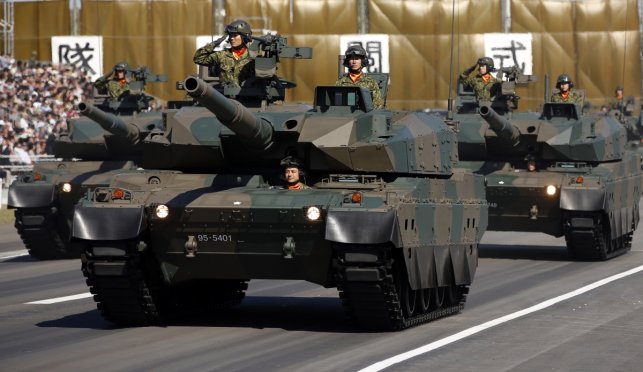
Japanese Prime Minister Shinzo Abe pressed ahead with the gradual expansion of mililtary budget, approving a 1.4 percent rise in the outlay for the next year -- the fifth consecutive rise in defence budget after he came to power in 2012.
With Japan's security focus gradually shifting to the East China Sea and the thret posed by North Korea, the pacifist nation has spent bigger on fighter jets, misile systems and submarines in recent years.
Here's a look at the timeline of the subtle and gradual changes in Japan's professed pacifism over the last 70 years:
Scars of World War II
The deep scars of World War II pushed the Japanese to an anti-war stance. The Constitution drafted after the war limited the use of force only as a means of self defence. The essence of Japan's pacifist stance under the US occupation was that it will refrain from using force to resolve international conflicts. This policy ruled out military alliances and intervention in regional military conflicts.
Korean Crisis
Japanese pacifism saw the earliest changes in the early 1950s when the US nudged Tokyo to 're-arm' as it looked to bolster its position during the Cold War. As the Korean War erupted the US withdrew its forces from Japan, leaving the country with no military to protect itself from any possible invasion. Then, under the behest of the US, a 75,000-strong National Police Reserve was formed in Japan to fill the military vacuum.
Emergence of Mao
Again, the regional balance had significantly changed from 1945 with Chiang Kaishek losing the Chinese civil war. The emergence of Mao and the communists in China meant that America lost another regional ally, and this was at the root of US rethinking on Japan's total pacifism.
Prime Minister Yoshida did not give in to pressure to form a military force for self defence and take on bigger stakes in the region but eventually in 1952 a new National Safety Agency was set up to oversee the NPR.
As per the post-war constitution Japan was never to have a regular army, navy or air force and hence the NPR was seen merely as an extension of the police force. However, the National Safety Agency eventually became the Japan Defence Agency or the Ministry o Defence.
In 1954, the National Police Reserve became the Japan Self-Defense Forces but Yoshida made sure the forces were minimalist.
In the 1970s US President Richard Nixon renewed US pressure on Japan to assume bigger regional role. In 1983, Prime Minister Yasuhiro Nakasone wanted to make an 'unsinkable aircraft carrier' triggering protests. Also under his rule Japan breached for the first time the de-facto military spending limit of less than 1 percent of GDP. Nakasone also cut a new path, allowing the export of military hardware to the US.
1990-91 Gulf War
Japan spent $13 billion in the war but with no active military participation, setting off debate over the country's efficacy in strategic interventions, this time the oil supplies. The call for becoming a 'normal nation' gained more traction.
Also a prosperous China's rising defence budget in the 1980s spooked Japan.
Japan initiated a plan to build a ballistic missile defence system (BMD) with US cooperation after the 1998 North Korea missile tests. In 2003 Prime Minister Junichiro Koizumi proclaimed BMD a national priority.
In 2001, in a minor yet symbolic departure from the stance during 1990-91 Gulf War, Koizumi decided to support America's war on terror following the 9/11 al-Qaeda attack, by sending forces to the Indian Ocean.
In 2007, marking the 60th anniversary of the Japanese Constitution, Prime Minister Shinzo Abe called for a "bold review" of the charter that paved the way for Japan's greater role in regional and global security.
Nationalist Shinzo Abe
Under Shinzo Abe, in 2014 Japan ended a ban on its armed forces operating abroad. The ban had been in place since 1945. Ending military seclusion by approving collective self defence meant that Tokyo can extend military support to a friendly country under attack, something which it had been proscribed from doing for decades.








